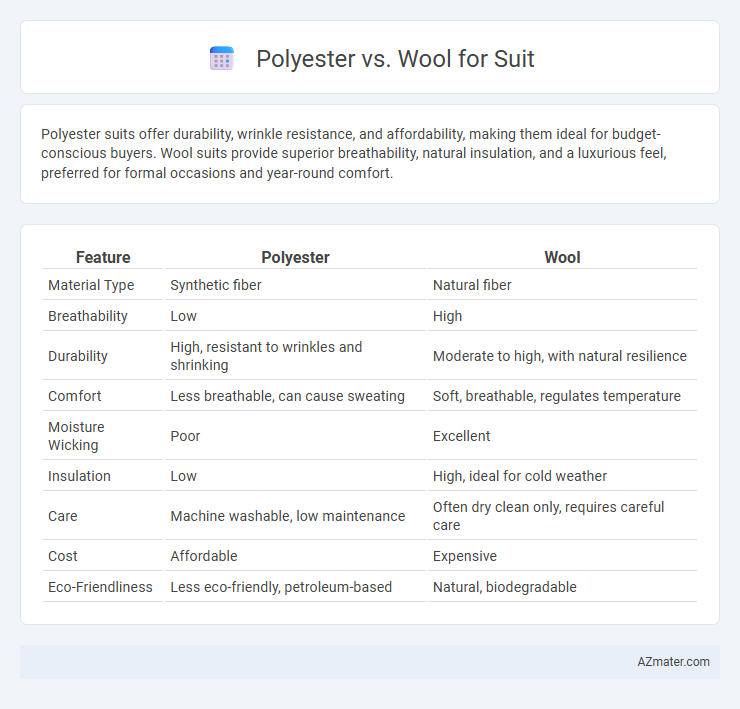Polyester suits offer durability, wrinkle resistance, and affordability, making them ideal for budget-conscious buyers. Wool suits provide superior breathability, natural insulation, and a luxurious feel, preferred for formal occasions and year-round comfort.
Table of Comparison
| Feature | Polyester | Wool |
|---|---|---|
| Material Type | Synthetic fiber | Natural fiber |
| Breathability | Low | High |
| Durability | High, resistant to wrinkles and shrinking | Moderate to high, with natural resilience |
| Comfort | Less breathable, can cause sweating | Soft, breathable, regulates temperature |
| Moisture Wicking | Poor | Excellent |
| Insulation | Low | High, ideal for cold weather |
| Care | Machine washable, low maintenance | Often dry clean only, requires careful care |
| Cost | Affordable | Expensive |
| Eco-Friendliness | Less eco-friendly, petroleum-based | Natural, biodegradable |
Introduction to Suit Fabrics: Polyester vs Wool
Polyester suits offer durability and wrinkle resistance, making them cost-effective options for everyday wear. Wool suits provide superior breathability, natural insulation, and a luxurious feel, favored for formal occasions and comfort in varying climates. Understanding the distinct fiber properties helps in choosing the right fabric based on occasion, budget, and personal style.
Material Composition: What Are Polyester and Wool?
Polyester is a synthetic fiber made from petroleum-based polymers, known for its durability, wrinkle resistance, and affordability, making it a popular choice for budget-friendly suits. Wool is a natural fiber harvested from sheep, prized for its breathability, moisture-wicking properties, elasticity, and natural insulation, providing superior comfort and temperature regulation in suits. Wool's natural crimps create air pockets that trap heat, while polyester lacks these breathable qualities, often resulting in less comfort for extended wear.
Durability and Longevity Comparison
Polyester suits offer high durability due to their resistance to wrinkles, shrinking, and stretching, making them ideal for frequent use and easy maintenance. Wool suits provide superior longevity with natural fiber strength, breathability, and resilience that improve with age, often lasting for decades with proper care. Wool fibers naturally regain shape and resist wear, while polyester tends to degrade faster under continuous abrasion, impacting long-term appearance and comfort.
Comfort and Breathability: Which Feels Better?
Wool suits excel in comfort and breathability due to their natural fibers that regulate temperature and wick moisture away from the skin, making them ideal for all-day wear. Polyester suits, being synthetic, often trap heat and moisture, leading to less breathability and a potentially uncomfortable feel during extended use. For those prioritizing comfort and airflow, wool remains the preferred fabric choice in tailored suiting.
Appearance and Style: Visual Differences
Polyester suits often have a shiny, smooth finish that can appear less natural compared to the matte, textured surface of wool suits. Wool fabric drapes better, providing a more structured and elegant silhouette, while polyester tends to look stiffer and less refined. The natural fibers in wool also allow for richer color depth and subtle patterns, enhancing the overall style and sophistication of suits.
Wrinkle Resistance and Maintenance
Polyester suits offer superior wrinkle resistance compared to wool, maintaining a smooth, crisp appearance throughout the day with minimal upkeep. Wool suits, while natural and breathable, tend to crease more easily and require more careful maintenance, including regular brushing and proper storage to prevent wrinkles. Polyester's easy-care properties make it ideal for frequent travelers, whereas wool demands professional cleaning and steaming to restore its polished look.
Suit Cost: Affordability of Polyester and Wool
Polyester suits offer a cost-effective option, with prices significantly lower than those of wool suits, making them ideal for budget-conscious buyers. Wool suits command higher prices due to the natural fiber's durability, breathability, and luxurious feel, often reflected in premium tailoring and longevity. Choosing polyester suits allows for affordable versatility but may involve compromises in comfort and breathability compared to pricier, high-quality wool alternatives.
Sustainability and Environmental Impact
Polyester suits, derived from non-renewable petroleum, contribute significantly to microplastic pollution and have a higher carbon footprint due to energy-intensive manufacturing processes. Wool suits, sourced from sheep, offer biodegradability and carbon sequestration benefits, but concerns arise from land use, methane emissions, and water consumption in wool production. Choosing between polyester and wool involves balancing synthetic waste and fossil fuel dependence against natural resource use and animal agriculture's environmental effects.
Ideal Occasions and Weather Suitability
Polyester suits excel in humid or rainy weather due to their water-resistant and wrinkle-retentive properties, making them ideal for outdoor events or travel. Wool suits offer superior breathability and insulation, perfectly suited for cooler climates and formal occasions like business meetings or winter weddings. Choosing between polyester and wool depends on balancing durability and comfort to match the event type and environmental conditions.
Final Verdict: Choosing Between Polyester and Wool for Your Suit
Selecting between polyester and wool for your suit depends on durability, comfort, and occasion. Wool offers superior breathability, natural insulation, and a refined appearance, making it ideal for formal events and all-season wear. Polyester suits, while more affordable and wrinkle-resistant, are less breathable and better suited for casual or budget-conscious buyers.

Infographic: Polyester vs Wool for Suit
 azmater.com
azmater.com